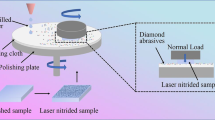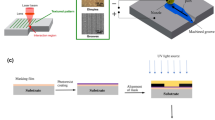Abstract
Resin coating films are extensively used for aesthetic improvement and preventing deterioration of metal surfaces. Some of the films contain fine metal particles for the purpose of coloring. For such films, surface waviness with millimeter-scale wavelength is a significant problem because it induces visible irregularities on the surface. Conventionally, man-powered polishing has been used to planarize the waviness. However, it is labor-intensive and leads to other problems such as waste slurry disposal and embedment of abrasive grains in the film. Hence, a new method is required to eliminate the surface waviness. In this study, ultrashort pulsed laser irradiation on resin coating films is proposed. By controlling the focal position and/or scanning speed of the laser beam along the surface, protrusions are preferentially removed. Firstly, the effects of pulse width, laser fluence, and scanning speed on surface morphology were clarified. Next, the material removal mechanism was examined by elemental analysis of the surface and its cross section after irradiation. Finally, as a preliminary result of surface flattening, the arithmetic mean waviness in the wavelength range of 2.4–5.0 mm was reduced by 45.3%. This study demonstrated the feasibility of selectively removing and flattening of resin coating films by substituting laser processing for man-powered polishing.















Similar content being viewed by others
References
Dumont-Bècle, P., Ferley, E., Kemeny, A., Michelin, S., & Arquès, D. (2001). Multi-texturing approach for paint appearance simulation on virtual vehicles. Sophia Antipolis.
Lawman, S., Zhang, J., Williams, B. M., Zheng, Y., & Shen, Y.-C. (2017). Applications of optical coherence tomography in the non-contact assessment of automotive paints. Optical Measurement Systems for Industrial Inspection X. https://doi.org/10.1117/12.2270020
Demirci, M., & Baǧcl, M. (2018). Investigation of automotive primer and basecoat paint surface’s adhesion by solid particle erosion. AIP Conference Proceedings. https://doi.org/10.1063/1.5034542
Deyab, M. A., Mele, G., Al-Sabagh, A. M., Bloise, E., Lomonaco, D., Mazzetto, S. E., & Clemente, C. D. S. (2017). Synthesis and characteristics of alkyd resin/M-Porphyrins nanocomposite for corrosion protection application. Progress in Organic Coatings, 105, 286–290. https://doi.org/10.1016/j.porgcoat.2017.01.008
Lambourne, R., & Strivens, T. A. (1999). Paint and surface coatings theory and practice. Woodhead Publishing.
Sugiura, K. (2007). Study on quantitative evaluation of surface micro-smoothness in coating films. Study of Paint, 148, 2–9.
Mirjalili, F., Moradian, S., & Ameri, F. (2014). A new approach to investigate relationships between certain instrumentally measured appearance parameters and their visually perceived equivalents in the automotive industry. Journal of Coatings Technology and Research, 11(3), 341–350. https://doi.org/10.1007/s11998-013-9544-9
Kang, H., Butler, C., & Yang, Q. (1999). Evaluation of metal texture effect on paint appearance. Three-Dimensional Imaging, Optical Metrology, and Inspection V, 3835, 202–209. https://doi.org/10.1117/12.370262
Yimit, A., Itou, A., Matsui, Y., & Akashi, T. (2019). Automatic visual inspection method for a coated surface having an orange peel effect. IEEJ Transactions on Electrical and Electronic Engineering, 14(3), 433–440. https://doi.org/10.1002/tee.22824
Fernholz, K. D. (2013). Quantifying the visibility of surface distortions in class “A” automotive exterior body panels. Journal of Manufacturing Science and Engineering. https://doi.org/10.1115/1.4007984
Jafari, R., & Ameri, F. (1998). Effect of orange peel attribute of automotive finishes on their blackness perception. Journal of Coatings Technology and Research, 15(5), 1003–1011. https://doi.org/10.1007/s11998-018-0046-7
Mirjalili, F., Moradian, S., & Ameri, F. (2014). Derivation of an instrumentally based geometric appearance index for the automotive industry. Journal of Coatings Technology and Research, 11(6), 853–864. https://doi.org/10.1007/s11998-014-9608-5
Konieczny, J., & Meyer, G. (2012). Computer rendering and visual detection of orange peel. Journal of Coatings Technology and Research, 9(3), 297–307. https://doi.org/10.1007/s11998-011-9378-2
Peters, C. A., Nichols, M. E., & Ellwood, K. R. J. (2011). The evolution of surface texture in automotive coatings. Journal of Coatings Technology and Research, 8(4), 469–480. https://doi.org/10.1007/s11998-011-9333-2
Oba, Y., & Kakinuma, Y. (2017). Simultaneous tool posture and polishing force control of unknown curved surface using serial-parallel mechanism polishing machine. Precision Engineering, 49, 24–32. https://doi.org/10.1016/j.precisioneng.2017.01.006
Oba, Y., Yamada, Y., Igarashi, K., Katsura, S., & Kakinuma, Y. (2016). Replication of skilled polishing technique with serial-parallel mechanism polishing machine. Precision Engineering, 45, 292–300. https://doi.org/10.1016/j.precisioneng.2016.03.006
Brygo, F., Dutouquet, C., Le Guern, F., Oltra, R., Semerok, A., & Weulersse, J. M. (2006). Laser fluence, repetition rate and pulse duration effects on paint ablation. Applied Surface Science, 252(6), 2131–2138. https://doi.org/10.1016/j.apsusc.2005.02.143
Zhao, H. C., Qiao, Y. L., Zhang, Q., Du, X., Zang, Y., Liu, X. T., & Han, B. Y. (2020). Study on the characteristics and mechanism of pulsed laser cleaning of polyacrylate resin coating on aluminum alloy substrates. Applied Optics, 59(23), 7053–7065. https://doi.org/10.1364/AO.387532
Veltrup, M., Lukasczyk, T., Ihde, J., & Mayer, B. (2018). Distribution and avoidance of debris on epoxy resin during UV ns-laser scanning processes. Applied Surface Science, 440, 1107–1115. https://doi.org/10.1016/j.apsusc.2018.01.154
Lippert, T., Hauer, M., Phipps, C. R., & Wokaun, A. (2003). Fundamentals and applications of polymers designed for laser ablation. Applied Physics A: Materials Science & Processing, 77, 259–264. https://doi.org/10.1007/s00339-003-2111-y
Kumar, A., Prasad, M., Shail, S., Bhatt, R. B., Behere, P. G., Afzal, M., Kumar, A., Kar, R., Nilaya, J. P., & Biswas, D. J. (2015). Pulsed laser-assisted removal of powder coating from galvanised steel surface: A characterisation study. Applied Physics A: Materials Science and Processing, 119(3), 853–858. https://doi.org/10.1007/s00339-015-9050-2
Li, X., Zhang, Q., Zhou, X., Zhu, D., & Liu, Q. (2018). The influence of nanosecond laser pulse energy density for paint removal. Optik, 156, 841–846. https://doi.org/10.1016/j.ijleo.2017.11.010
Shamsujjoha, M., Agnew, S. R., Melia, M. A., Brooks, J. R., Tyler, T. J., & Fitz-Gerald, J. M. (2015). Effects of laser ablation coating removal (LACR) on a steel substrate: Part 1: Surface profile, microstructure, hardness, and adhesion. Surface & Coatings Technology, 281, 193–205. https://doi.org/10.1016/j.surfcoat.2015.01.071
Shamsujjoha, M., Agnew, S. R., Brooks, J. R., Tyler, T. J., & Fitz-Gerald, J. M. (2015). Effects of laser ablation coating removal (LACR) on a steel substrate: Part 2: Residual stress and fatigue. Surface and Coatings Technology, 281, 206–214. https://doi.org/10.1016/j.surfcoat.2015.02.034
Kreutz, E. W., Frerichs, H., Stricker, J., & Wesner, D. A. (1995). Processing of polymer surfaces by laser radiation. Nuclear Instruments and Methods in Physics Research Section B: Beam Interactions with Materials and Atoms, 105, 245–249. https://doi.org/10.1016/0168-583X(95)00539-0
Jang, P. R., Kim, C. G., Han, G. P., Ko, M. C., Kim, U. C., & Kim, H. S. (2019). Influence of laser spot scanning speed on micro-polishing of metallic surface using UV nanosecond pulse laser. International Journal of Advanced Manufacturing Technology, 103, 423–432. https://doi.org/10.1007/s00170-019-03559-8
Yan, J., & Kobayashi, F. (2013). Laser recovery of machining damage under curved silicon surface. CIRP Annals—Manufacturing Technology, 62, 199–202. https://doi.org/10.1016/j.cirp.2013.03.109
Kobayashi, T., Sera, H., Wakabayashi, T., Endo, H., Takushima, Y., & Yan, J. (2018). Surface flattening and nanostructuring of steel by picosecond pulsed laser irradiation. Nanomanufacturing and Metrology, 1(4), 217–224. https://doi.org/10.1007/s41871-018-0023-x
Hamad, A. H. (2016). Effects of different laser pulse regimes (nanosecond, picosecond and femtosecond) on the ablation of materials for production of nanoparticles in liquid solution. In R. Viskup (Ed.), High energy and short pulse lasers (pp. 305–325). IntechOpen. https://doi.org/10.5772/57353
Guo, B., Sun, J., Hua, Y., Zhan, N., Jia, J., & Chu, K. (2020). Femtosecond laser micro/nano-manufacturing: Theories, measurements, methods, and applications. Nanomanufacturing and Metrology, 3, 26–67. https://doi.org/10.1007/s41871-020-00056-5
Author information
Authors and Affiliations
Corresponding author
Additional information
Publisher's Note
Springer Nature remains neutral with regard to jurisdictional claims in published maps and institutional affiliations.
This paper was presented at PRESM2020.
Rights and permissions
About this article
Cite this article
Nakajima, A., Yan, J. Response of Resin Coating Films Containing Fine Metal Particles to Ultrashort Laser Pulses. Int. J. Precis. Eng. Manuf. 23, 385–393 (2022). https://doi.org/10.1007/s12541-022-00629-y
Received:
Revised:
Accepted:
Published:
Issue Date:
DOI: https://doi.org/10.1007/s12541-022-00629-y




